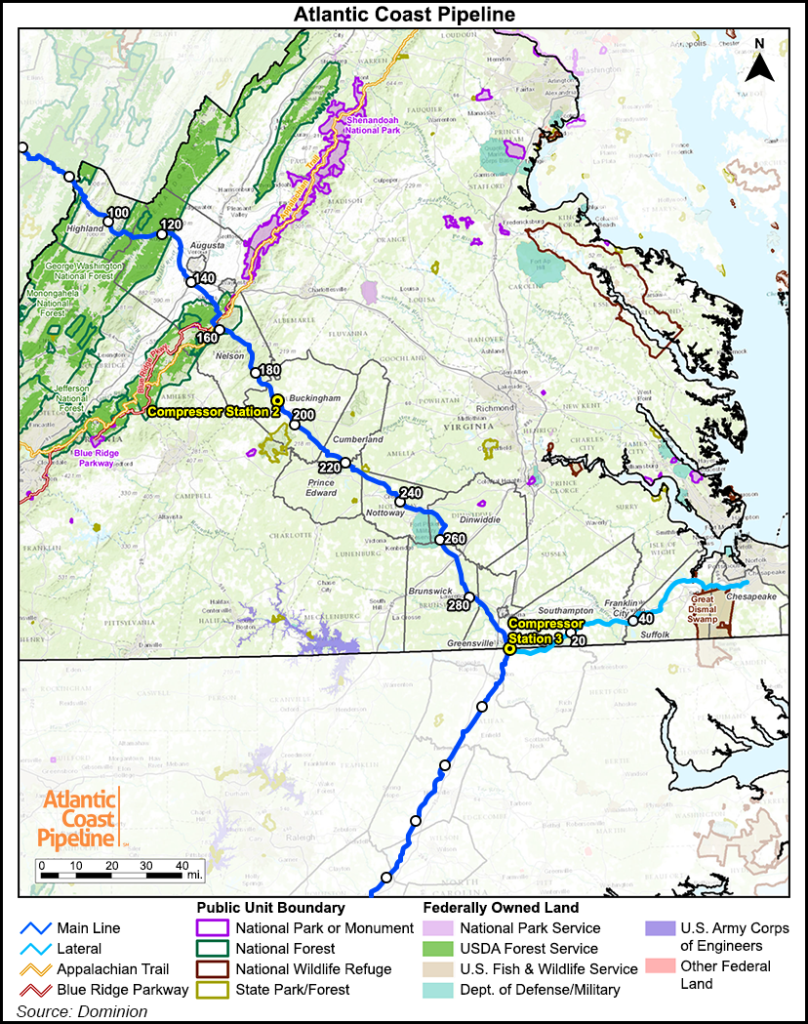Regulatory | Infrastructure | NGI All News Access
Atlantic Coast Answers FERC’s Questions on Alternative Route, Awaits Draft EIS
Atlantic Coast Pipeline LLC (ACP) on Friday completed the last in a series of supplemental filings to FERC in response to information requests the agency submitted in December 2015 and January 2016.

Friday’s 7,000-plus page filing brings the project closer to receiving a draft environmental impact statement (EIS) from the Federal Energy Regulatory Commission, with the next step being for the Commission to issue a notice of schedule to set a timeline for the rest of the environmental review process.
The supplemental filings have addressed the FERC’s inquiries while also detailing updated alignment sheets, tables and resource information related to a number of alternative routes adopted since the project initially filed with FERC last September (see Daily GPI, Sept. 18, 2015).
One of the most notable route changes for ACP came after the U.S. Forest Service (USFS) rejected the pipeline’s original proposed route through the George Washington and Monongahela national forests, a change that impacted an additional 249 landowners in counties along the West Virginia/Virginia border (see Daily GPI, Feb. 12; Jan. 22). USFS cited impacts to protected species and habitat in its decision not to OK the original route through the national forests.
ACP spokesman Aaron Ruby told NGI that a “significant number of the questions” in FERC’s December and January data requests related to issues raised by the USFS. The pipeline has also undergone a number of other minor route changes to address stakeholder concerns, Ruby said.
A recent tally from executives with ACP-backer Dominion had the 1.5 Bcf/d pipeline’s route approaching 600 miles (see Daily GPI, March 23). The pipeline would start in Harrison County, WV, before crossing into Virginia and North Carolina, interconnecting with the Transcontinental Gas Pipe Line along way to bring Marcellus and Utica shale gas to markets in the Southeast.
The project is a joint venture between Dominion, Duke Energy, Piedmont Natural Gas and AGL Resources.
The greenfield ACP, which aims to cross through rural counties in Virginia and West Virginia, has faced vocal opposition from landowners and environmental advocates. Some landowners along the route have attempted to stall the project by denying access for survey work (see Daily GPI, Feb. 4), while environmental groups have called for FERC to develop a programmatic EIS of ACP and other pipeline projects proposed in response to the rapid growth in production in the Appalachian Basin (see Shale Daily, Nov. 2, 2015).
Meanwhile, a period of “heightened infrastructure opposition” and a large volume of pipeline applications to FERC has raised concerns about the potential for projects to be delayed (see Daily GPI, Dec. 1, 2015).
Ruby said the ACP is on schedule to meet its planned 2018 in-service date. He estimated that ACP has received permission to survey more than 85% of its proposed route and has actually surveyed more than 80%.
The FERC process is “designed to address the interests and concerns of all stakeholders” and is working as intended in the case of ACP, he said.
“I think the process has been extraordinarily thorough and comprehensive,” Ruby said. “The number of data requests we’ve received — the detail contained in those requests — is evidence of how thorough the process is.”
© 2024 Natural Gas Intelligence. All rights reserved.
ISSN © 1532-1231 | ISSN © 2577-9877 |
